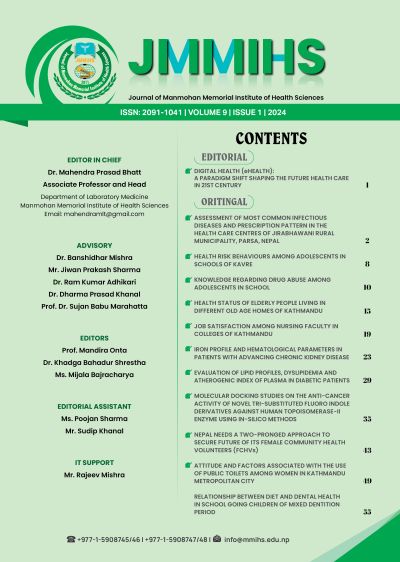Attitude and Factors Associated With the Use of Public Toilets among Women in Kathmandu Metropolitan City
DOI:
https://doi.org/10.3126/jmmihs.v9i1.68642Keywords:
Attitude, women, KMC, public toiletsAbstract
Background: The UN general assembly has identified sanitation as distinct human right. Along with the discovery of infectious diseases and changing lifestyle patterns in urban areas, sanitation needs have grown. As per the standard set by WHO, one toilet at 500m distance per 50 people is needed, which is unmet. Moreover, due to biological processes such as menstruation and high vulnerability to infections, women have a higher sanitation need.
Methodology: The study was descriptive, cross-sectional, conducted among 255 respondents. A purposive sampling method was applied, and respondents were interviewed using a pre-tested questionnaire. The collected data were entered and analyzed in IBM SPSS
Results: Out of the 255 respondents, 92% have used a public toilet at least once. Less than half (42.7%) of the respondents preferred to use a pay per use public toilet. Most of the respondents (93%) said that they were not satisfied with the state of public toilets. More than half (54.5%) had negative attitude towards using public toilets. Attitude towards using public toilets was found to be associated with their preference of type of toilet, importance of light, ventilation, soap, and absence of smell inside the toilet.
Conclusion: Most women were unsatisfied with the status of public toilets and would prefer not to use a pay per use toilet. Higher number of respondents having negative attitude towards using public toilets is justified by the findings from observation of the public toilets as well. An intervention to improve the status of public toilets and to make the public realize their ownership to maintain good status of public toilet seems to be needed.
Downloads
Downloads
Published
How to Cite
Issue
Section
License
© Journal of Manmohan Memorial Institute of Health Sciences (JMMIHS)
All rights reserved to JMMIHS. Any part of this journal cannot be reproduced, or transmitted in any form including electronic mail, photocopying or recording or otherwise without prior written permission of the publisher.




